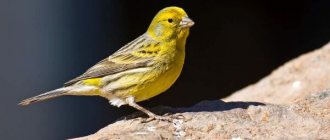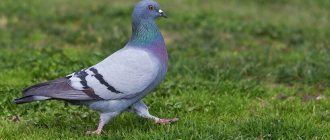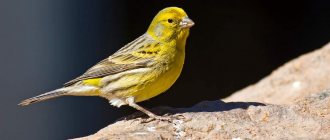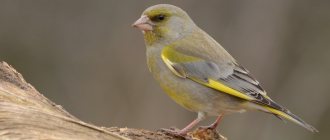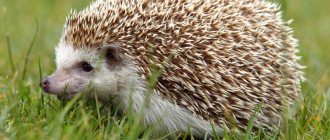Canaries were domesticated back in the 15th century. In those days, many people could afford to have this bird at home. It was soon noticed that they have amazing singing abilities, and when crossed, new, unusual species are obtained. Thus began breeding experiments with canaries. And now many varieties of these birds have already been bred. All species were grouped into three large categories: singing, colored, decorative.
Origin, description, difference between a canary and a canary
The history of its appearance dates back to the 14th century, when Spanish conquerors arrived in the Canary Islands and occupied the territory. There they noticed small bright birds that amazed with their iridescent singing. Local residents have already managed to tame them.
The canary bird brings joy to people
Then the Spaniards decided to bring such birds to Europe and named them after the area where they were found. What a canary is as a pet was later appreciated by poultry lovers.
A canary is a bird belonging to the order Passeriformes, family Finaceae, genus Canary finches, subspecies - domestic canary. Body size ranges from 15 to 25 cm in length, weight up to 60 grams. The most common plumage colors are yellow, orange and red.
For reference! Scientists have discovered and bred more than 100 species of canaries, among which you can find representatives of green, white, blue and rare scaly colors.
Different colors of canaries
Thanks to new species that were obtained through crossing by scientists, there are representatives with tufts on their heads or fancy waves.
The color of feathers can change depending on living conditions, climate and food. Despite the ability to easily adapt to new conditions, birds are very sensitive to danger, for example, emissions of toxic gases.
The male canary is called a canary. To understand how to distinguish a canary from a canary, you need to pay attention to the tail - in females it is shorter. When singing, the canar's crop increases significantly. Males sing protractedly and deeply, while females sing much quieter and more intermittently.
Note! Also, if you take a bird in your hand and look at its cloaca, in females it is flat and has a fur covering, while canaries are endowed with a cylindrical cloaca.
Singing row
Russian breed
The wild canary appeared in Russia in the seventeenth and eighteenth years. The Russian canary has not received registration from the World Confederation of Bird Fanciers, but in Russia it is officially recognized. Although the breed does not have a special hereditary singing, the Russian canary is considered the most popular Russian songbird. Mostly all birds have yellow plumage, but the redwood canary is also known.
The Russian canary gained fame in the late nineteenth and early twentieth centuries. Tavern owners, having no money to hire singers, entertained visitors with canary songs. The first canary singing competitions began to be held in taverns.
Breeders taught canaries to sing using whistles, pipes, and songs of forest birds. Soon the first variety appeared - the Russian canary of the oatmeal tune, which learned from the forest bunting.
Gradually, the Russian canary learned several variations of tunes: the song of the Linen Factory, Pavlovian songs, and the Ryabov tune.
Among the Russian singing of these birds, the direction of modern forest melodies is popular. The common forest canary does not purposefully learn. It is her natural singing, passed on through inheritance, that is valued.
Types and Species of Canaries
By type they are divided into three groups:
- colored,
- decorative,
- singers
Within each group, birds are divided into different species. There are much more colorful and decorative individuals than songbirds, of which there are only a few species.
Depending on the presence of the coloring pigment - melanin and lipochrome - in the body, a distinction is made between melanin, that is, darker-colored birds, and lipochrome, that is, lighter-colored birds.
Lipochromics include:
- yellow canaries are most often found in home breeding;
- white - divided into English and German canaries;
- red, this also includes individuals of an orange hue;
- ivory with pink hues;
- Albinos are individuals with red eyes.
The coloration of melanin birds is more diverse and the following subspecies are distinguished:
- black - birds with a bronze, red-black, copper or greenish color;
- agate is found in green-agate, bronze-agate and silver-agate shades;
- brown - plumage varying from dark to light brown shades;
- isabella - these include representatives of brown canaries with a small amount of pigment and a pale pattern on the feathers.
Additional Information! What color a canary is is determined not only by the presence of pigment, but also by the cell structure itself. For example, the blue canary has a transparent layer in the structure of the cells covering the pigment, due to which the effect of light refraction gives a blue tint to the color.
Among the decorative group there are five types:
- hunchback,
- curly,
- curly,
- painted,
- crested.
From the side, the humpback canary looks like it is hunched over - the body is stretched vertically, and the head is forward and lowered very low. Body size is approximately 21-23 cm. Within this species, several breeds are distinguished - Belgian, Scottish, Japanese, Munich and Jiboso. Most often, representatives of this species can be seen in white or yellow shades of plumage.
humpback canary
Curly-haired representatives include northern curly-haired, French, Swiss, Milanese and Paduan curly-haired, Italian gibbers and Parisian trumpeters. They were originally bred in Holland. A distinctive feature of this type is the presence of curls in the chest area. Curly-haired individuals are quite demanding in care; they eat only special food. The disadvantage is the lack of warm maternal feelings for their offspring. Body length ranges from 17 to 2 cm.
Curly canaries have smooth, neat plumage that fits tightly to the body. Subspecies include Spanish, Swiss, Norwich, Yorkshire and Border canaries. The sizes and characteristics of different subspecies vary. For example, the Border subspecies is distinguished by its graceful posture and small body size of up to 14 cm, while the Norwich subspecies has a large stocky body with a short tail and legs. The unifying feature of this type is a downward gaze.
The Painted Canary comes in two breeds: London and Lizard. The Londoner changes its color throughout its life, so with age, the bright plumage is replaced by a more modest and calm one. The lizard, or lizard in other words, is so named because it has a certain scaly pattern. Just like London canaries, the bright contrasting color of the lizard's plumage can disappear with age.
Crested breeds were bred in Germany, among which four stand out - German, English, Lancashire and Gloucester. The name of the species defines a special difference between the birds for itself - the presence of a crest. It can be quite large and cover the eyes, like the German Crested, or fit tightly to the head and be almost invisible, like the Gloucester breed.
Among the breeds of singing canaries are the Belgian Malinois, the German Roller, the Russian Songbird, and the American Singer. Their singing resembles the murmur of water, whistling, melodious and drawn-out chirping.
History of the development of canary breeding
The wild canary was domesticated in the sixteenth century, and was a great rarity. At the beginning of the seventeenth century, a domestic canary was no longer a luxury, and many could afford to purchase a bird. Due to their wide distribution, exotic lovers could freely breed these birds.
Each breeder kept and fed the birds in his own way. Different living conditions led to the fact that birds with natural green plumage began to have yellow chicks.
Breeders from different countries became interested in this mutation. From all the chicks, they selected the most unusual birds and used them in breeding to consolidate the new color. In a short time, breeders were able to develop more than thirty color variations: lemon, red, white and others.
- The rarest cat breeds
- German Shepherd
- What kind of snakes are kept at home?
- Ancient dog breeds
- Dog's sense of smell
- Maine Coon
Some breeders went further and began to breed birds of other sizes and shapes. Not only the proportions of the body were changed, but also the structure of the feathers. English breeders have done particularly good work in this direction.
But the Germans attached great importance to the singing of birds and fixed the genetic characteristics responsible for musical abilities. Modern breeders have learned to work purposefully, relying not on intuition, but on genetics. Now breeders are able to anticipate and plan for the appearance of many features in these birds. For example, the color of future chicks.
Living in natural conditions
Experienced ornithologists tell us where the canary lives in the wild and what it eats. The main place where the canary bird lives in natural conditions is the Azores and Canary Islands.
Canaries in natural conditions
The way of life is to unite in small flocks of their relatives and fly between small trees or bushes in search of food. For eating, they prefer seeds, various plants and small insects.
As night approaches, canaries gather in larger flocks and find a quiet, secluded place to spend the night. In the morning they scatter again and form small, constantly chirping clusters.
Appearance
The domestic canary has a slightly larger body size than its natural wild ancestor . All colored singing domestic canaries are characterized, as a rule, by a maximum body length in the range of 13.5-14.5 cm, but ornamental birds of this species are known to have a larger or rather small body.
Canaries are distinguished by harmonious shapes, a rounded and very well-formed head, as well as the presence of a short and pin-shaped beak. The most famous and widespread at present is the classic yellow plumage.
However, today there is a great opportunity to purchase a feathered pet with original white, red, chocolate brown or light brown plumage. The canary's red feathers are the result of crossing a canary with a fire siskin.
Among other things, some modern breeding forms of canaries have a clearly visible crest or special curls. The canary's flight path is wavy, very reminiscent of the flight of a wild finch.
Caring for your pet at home
Despite the unpretentiousness of caring for this pet, it is advisable to learn everything about canaries and follow a few simple rules.
When choosing a cage for your pet, you need to consider whether he will live in it alone or if further reproduction is planned. To keep one canary, a regular cage without additional extensions and decorative elements is suitable. The main thing is that it is spacious enough.
Important! If you plan to breed birds, the female and male should live in separate cages (except during the breeding season). The newly hatched chicks live with the female for the first time.
The cage must have several crossbars so that the bird can fly from one to another. There should also be several bowls for food.
Canary cage
Since canaries love to bathe, you need to put a small bath in the cage. It can stand on a stand or directly on the floor. Water must be changed when it becomes dirty.
Drafts or severe overheating are dangerous for canaries, so you need to carefully choose the location of the cage - away from windows and radiators. The room where the cage will be placed must have dry and warm air, sufficient lighting, and avoid direct sunlight. In warm summer weather, it is permissible to take the cage out onto the loggia.
Pet store sellers can tell you what canaries eat at home. Balanced canary food is used for feeding. Certain periods of life may require the purchase of special food, for example, during the molting or breeding season.
Attention! It is recommended to feed your pet one type of food most of the time. A sudden change in diet can negatively affect the health of the bird.
The feed rate must be observed based on individual calculations. It is worth remembering that eating a lot is also harmful, it can lead to obesity.
Health, disease and prevention
A sick pet must be placed in a separate, so-called quarantine cage.
The most common, widespread diseases of canaries can be represented by:
- growths on the paws;
- intestinal blockage;
- constipation and diarrhea;
- catarrh of the upper respiratory tract;
- colds;
- metabolic disorders;
- injuries, fractures and wounds;
- goiter inflammation;
- vitamin deficiency;
- paratyphoid;
- liver pathologies;
- tuberculosis;
- diphtheria;
- loss of voice;
- baldness;
- internal and external parasites.
For the purpose of prevention, it is very important to fully comply with the regime for keeping domestic birds in captivity, maintain cleanliness in the cage and provide the canary with complete, balanced food. If there are sudden changes in the bird’s behavior, the appearance of lethargy or apathy, loss of appetite, or abnormal bowel movements, it is very important to consult a veterinarian as soon as possible.
Canary diseases
With proper care and maintenance, canaries very rarely get sick, but there are times when health problems occur. Every owner should know what a canary looks like when a disease occurs.
Important! If any disease is detected, first of all you need to put the bird in a separate cage. Then thoroughly rinse and disinfect her house, all bowls and bedding.
Among the diseases, birds can be susceptible to colds, such as rhinitis and laryngotracheitis. This happens when the pet is kept in conditions with low temperatures. The first symptoms will be depression, loss of appetite, wheezing, and nasal fluid. If this is detected, it is necessary to start spraying antiseptic solutions, give a weak solution of manganese instead of water, and it is possible to lubricate the larynx with sunflower oil.
If the crop is blocked due to the consumption of low-quality food, it is necessary to remove all food and leave only water, slightly diluted with lemon juice. After 8-10 hours, you can start feeding well-cooked rice or oats. Frequent blockage of the goiter will require contacting a specialist and possible surgical intervention.
At the veterinarian's appointment
Cases of tracheal mite infection are common. This can be noticed by coughing, sneezing, and regurgitation of food. In addition to refusing food, the canary constantly itches, behaves lethargically, and reacts poorly to sounds. Treatment of this disease is possible only after a thorough examination by a veterinary clinic specialist who will prescribe medications. Self-treatment or advanced disease can lead to the death of your pet.
Lifestyle and behavior
The vocal bird nests willingly and near estates, delighting their residents with its vocals nine months a year. It was first domesticated in 1495 by the Spanish conquerors of Madeira. They were able to monopolize the highly profitable trade in the exquisite songbird for a time, keeping its place of origin a deep secret.
Canaries live in pairs; in the fall they gather in flocks of 30 to 50 birds. The nest is very carefully and skillfully built by the female, placing it in the dense crown of trees or thorny bushes at a height of at least 2.5 meters. The eggs, which usually number from 3 to 5, are incubated by both parents. Young birds at 14 days old already leave the nest, at 21 they become independent, and at 35 days the males begin to sing. Wild canaries feed on grass seeds, fruits and young plant buds, and destroy insect pests and their larvae.
The bird has an innate ability to remember and repeat various sounds. The singing of a domestic canary differs in great variety from the singing of its wild relative. Over the course of many years of selection, her vocal apparatus has significantly improved and her body size has increased.
Song canaries reach a length of 13 to 15 cm, decorative ones from 12 to 22 cm. The most common plumage is yellow, but it can also be red, brown, white and fawn. Their color was originally green-brown on the head, gradually turning into yellow on the abdomen.
As selection progressed in the 16th century, a yellow canary was bred in Italy, and later a white and brown one. As a result of its crossing with the fire siskin, a red variety arose.
Singing
Closely related to singing is the ability of canaries to listen. Optimal sensitivity is between 3,200 hertz and 4,000 Hz. The lower threshold of hearing is located at 1,100 Hz, and the upper at 10,000 Hz. In addition, the canary can distinguish sequences of sounds, store them in memory and reproduce them. Therefore, she can learn the singing characteristic of the species. She can imitate the sounds and sound patterns of other birds, and also incorporate other people's noises into her singing.
The canary's song begins with an alternating, quiet entry of several knees and culminates in a very loud tour of harsh descending elements. The male sings very long stanzas built from many rounds or phrases. The knee begins with an alternating, quiet entry of several elements and culminates in a very loud tour of hard descending elements. Wild birds, in contrast to the Harz roller, lack deep phrases, which were the result of selection. The Canary finch can have up to 400 elements in its arsenal and thus sings more diversely than the bred forms. However, in both cases, a variety of sound units should be taught, which can expand throughout life.
Interesting Facts
- Miners often took canaries with them. The fact is that the bird is highly sensitive to carbon monoxide, so it could serve as an alarm in case of danger.
- Many writers and composers sang canaries in their works. As for composers, they tried to create similar sounds in their musical works.
- Canaries are very cute and sociable birds. With good care they can live up to 15 years.
- Thanks to the mixing of different species, it was possible to develop many unique subspecies, for example, the American Singer, the crested canary.
- The canary got its name in honor of the Canary Islands.
- The first to come up with the idea of domesticating the canary were the Spanish monks.
Video
Keeping a heterosexual pair of canaries without offspring
Many people think that the cohabitation of a male and female in the same cage will negatively affect the musical abilities of the canary. This is partly what happens, only temporarily, because in this case there is no need to attract the female by singing, and then also feed the children... However, during the period of incubation and outside the breeding season, the canary will sing so inspiredly that it will completely satisfy any demanding listener . It is during this period of satisfaction that the male sings his best trills.
If you want to have a full-fledged pair and keep them in the same cage, but do not want them to breed, then buy them young and at the same time so that both are new, and in the spring, during the breeding season, buy a nest and artificial eggs (layings), when the female will spread - replace the real ones with artificial ones, just throw away the real ones, let the female incubate the artificial clutch for two weeks, then rest, and so on three times. With such a reception, there will be no offspring, and the couple will feel complete and comfortable. Min. The length of the cage for a couple is 50cm.
Learn in detail about the artificial nesting cycle of a female canary:
MORE DETAILS
How to introduce canaries to create a married couple?
The most win-win option is to initially ask the breeder from whom you are going to purchase birds to make a pair not only according to breed characteristics and rules, but also according to character. This is not difficult for an experienced breeder to do, because he knows his birds well, having six months to determine both breed and mental characteristics until the birds are ready for sale.
If we are talking about introducing canaries of different characters and ages, from different breeders, then this issue needs to be approached more seriously.
MORE DETAILS
Keeping two female canaries
Some bird lovers and connoisseurs of their beauty, having keen hearing and not wanting to listen to the singing of canaries every day, buy only the female, providing her with a full cycle, the same as in a pair. If you purchase a second female to accompany a female, then you need to take into account the characters of both - they, like males, can rarely coexist peacefully in the same cage during the breeding season. Min. The length of the cage for keeping a female canary alone is 35 cm.
The ideal option for keeping two same-sex canaries is a spacious cage with a partition, which can always separate conflicting birds without depriving them of communication.
Keeping several pairs of canaries in one cage
Firstly, the more birds there are, the more spacious the cage should be; it is better if it is an aviary in which several different-sex canaries and other birds can coexist. But you need to realize that in such a company the main male will always appear, which will make it impossible to form the right pairs during the breeding season, since he will cover all the females after the males of the lower rank, also fights are not excluded, and the only advantage in such an enclosure is keeping a flock birds - this is that more often fights will turn into catch-ups, but then the remaining males run the risk of bruises and injuries, in an attempt to quickly hide from the angry leader of the flock. In a large company, they often contain only growing young animals until puberty, or females during the period of rest and molting. Min. The length of a cage for keeping a flock of canaries - an aviary - is from 75 cm.
In any case, before making a choice, you need to understand that you take full responsibility for the health and mood of your feathered pets, which now depends solely on you!
author: Filatova Oksana
Canary nursery "Ah, Harlequin"
If you are still in doubt about your choice or have any questions, just write us a letter, we will be happy to help you decide!
read other articles from the category
Share:
- Click to share on WhatsApp (Opens in new window)
- Click here to share content on Facebook. (Opens in a new window)
- Click to share on Telegram (Opens in new window)
- Click to share on Pinterest (Opens in new window)
- Click to print (Opens in new window)
